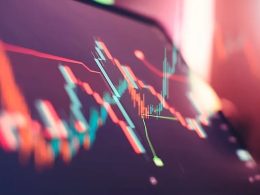“The Wile E. Coyote Stock Market?”
Jeffrey Saut, Chief Investment Strategist, Raymond James
April 14, 2014
Last Wednesday, when the D-J Industrials were up some 180 points, I could not shake the feeling that this was the “Wile E. Coyote stock market.” The visual is when Wile runs off a cliff, but his feet keep moving, until he looks down and realizes there is nothing underneath him. The resulting fall was similar to what happened late last week to the equity markets. Indeed, I really did not understand, or trust, last Wednesday’s Dow Wow for the reasons mentioned in these missives. As well, my writings all this year have noted that a 40+% rally, like we have experienced since June of 2012 without so much as a 10% decline, has historically been followed by a 5%-7% pullback in the first three months of the new year, with a 10% - 12% decline due sometime during the year. That view was reinforced by the recent rotation out of last year’s high fliers, which historically has preceded further selling in the overall stock market. Also, the “high flier” selling took the NASDAQ Composite (COMPQ/3999.73) below its 100-day moving average (DMA) a week ago for the first time in over a year. That telegraphed continued selling, not only in the “fliers,” but the overall stock market. Additionally, I have written the S&P 500 (SPX/1815.69) has “bonked” three times into the 1835 -1840 support zone and was likely destined to fail in a fourth test of that level. And, almost on scrip, the SPX knifed through that support zone late last week, bringing into view the next support level of 1780 – 1800. Interestingly, the reasons for that breakdown were given by a number of portfolio managers, and by numerous media anchors, I spoke to in New York City last week.
One of the first reasons given was the Ukraine situation. To wit, last week’s comments by NATO’s chief that troops may be moved into Eastern Europe caused Putin to worry the Kiev government would use that show of strength to announce an alliance with the West and potentially petition to join the European Union. If so, it was feared Putin would supersede said troop movement and annex the rest of the Ukraine. In fact, Friday’s Wall Street Journal carried a story titled, “NATO Says Russia Is Ready to Strike.” Next on the downside “hit parade” was the announcement of the Supplementary Loan Ratio (SLR), which raised fears the big banks would not be able to meet the SLR’s mandate, but as our analyst writes:
“U.S. regulators approved a finalized supplementary leverage ratio (SLR) for the nation's eight largest financial institutions. This was not a big surprise, as U.S. banking regulators chose to adopt Basel's treatment for the denominator of the SLR, while sticking to the 5% bank holding company and 6% subsidiary minimum required levels proposed last July. There were some changes in adopting the global standards for the denominator, but we believe all the banks in our coverage universe can easily get there well in advance of the January 1, 2018 deadline. Companies will be required to disclose their estimated SLR under the new rule starting on January 1, 2015. Regulators said including the revised rule, the estimated capital shortfall at the eight banks was $68 billion, which represented less than 10% of the outstanding tangible common equity at the affected institutions as of December 31, 2013. Banks should be able to exceed the proposed minimums without any capital raises.”
However, JP Morgan’s (JPM/$55.30/Strong Buy) shortfall on Friday did not help confidence about the statement, “Banks should be able to exceed the proposed minimums without any capital raises.” Then there was the slowing economic news from China, where exports and imports fell unexpectedly in March. Exports dropped 6.6% on a same month basis, following an eye-popping 18% decline in February on a year-over-year basis. Meanwhile, imports slid 11.3%. Parsing the numbers showed China’s internal and external demand is indeed slowing. Adding to Wall Street concerns about a slowdown was this statement from China’s Premier Li Keqiang, “We will not resort to short-term strong stimulus policies just because of temporary fluctuations.” Obviously Wall Street read that as no short-term help for the world’s second largest economy.
So those were the major boogeymen served up as the causa proxima for last week’s wilt, but for whatever the reason, the SPX finally fell through its 1835 – 1840 support zone. This is not an unimportant event for that level had supported stocks on numerous occasions. That’s why I wrote in last Thursday’s Morning Tack, “However, if the SPX declines a fourth time into its 1835 – 1840 support, it would be worrisome, at least to me. Worrisome because of the old stock market saw, ‘Triple bottoms typically do not hold’!” And notice how much the selling intensity increased when it became apparent the 1835 – 1840 level was going to fail to hold, bringing into view the next support zone of 1780 – 1800. Failing that would imply a test of the January/February “lows” at the 1740 – 1750 level. Whether this is the 10% - 12% correction I have cautioned would be due sometime this year based on historical precedent is unknowable at this point; but if it is, it would target the 1702 (10%) to 1664 (12%) zone. While I believe such a move is unknowable quite yet, the always eagle-eyed Jason Goepfert notes:
“There have only been two other times in the past 20 years that the Nasdaq Composite had dropped more than -8% from its 52-week high, but the VIX "fear gauge" was still below 17.5, a scenario we have now. It shows relative complacency in the face of a sell-off in higher-beta stocks. Those two occurrences were March 28, 2002 and May 15, 2008. The S&P 500 sold off more than -15% over the next three months both times.”
The call for this week: Last week I was in NYC seeing institutional accounts and doing media appearances. It was great to catch up with a number of my friends at CNBC, Bloomberg, Fox, Yahoo Finance, Arise TV, NYT, etc., but I think the highlight of the week was speaking on a panel for the Tiburon CEO Summit at the Ritz Carlton. On the panel was my friend Rich Bernstein, along with Ron Baron, Derek Young, and me. I began my opening remarks by stating, “I have thought a lot about what is the most important thing I can convey to this august group of 270 CEOs from the financial industry. I think it is that we are in a secular bull market, which has years left to run. The problem is many of the folks in this business have never seen a secular bull market. Their shared experience over the past 15 years has been to buy a stock, and when it rallies 30%, to sell it and look to find another stock to do the same thing. They have not experienced buying high-quality, blue chip/dividend-paying stocks, and holding them through a secular bull market like 1982 – 2000. Manifestly, in such a secular ‘bull’ the art of just ‘sitting,’ without a whole lot of activity, is one of the secrets of compounding wealth. To be sure, there will be pullbacks, so raising cash and repositioning portfolios along the way makes sense, but you should not go into a big cash position.” Following our panel, I was in the lobby of the Ritz when Ron Baron, eponymous captain of Baron Capital, asked me if I would like a ride back to mid-town. Since it was raining, that ride lasted an hour and a half during which we discussed a number of stocks. In fact, I have a number of new names to research this week. As for the stock market, in the near term the McClellan Oscillator is very oversold (chart 1), as well the SPX is at the low end of its 1-year trading range (see chart 2). The blue zone represents one standard deviation above/below the SPX’s 50-day moving average. But in January/February of this year, the SPX traded into the deeply oversold green zone, which marked the yearly “lows” in the aforementioned 1740 – 1750 area. Accordingly, it would not surprise me to see a rally attempt. However, with very little internal energy, I don’t think any rally is sustainable in the short term. Moreover, we could be in one of these 17 – 25 session “selling stampedes” with today being day number 7.

















